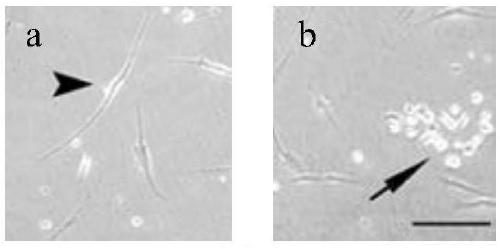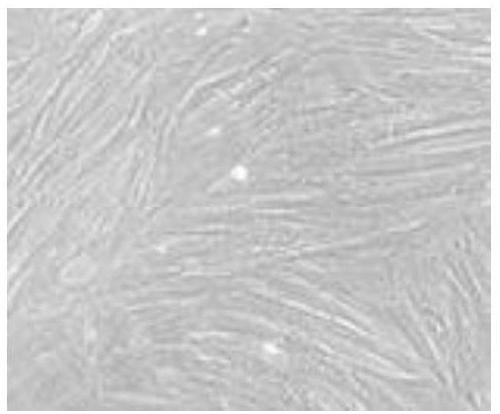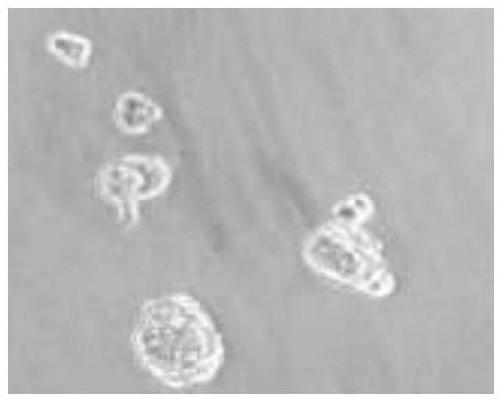Method for promoting differentiation of mesenchymal stem cells into neurons
A technology of mesenchymal stem cells and neurons, applied in the field of promoting the differentiation of mesenchymal stem cells into neurons, can solve the problems of high molecular weight of neurotrophic substances, increase the proportion of positive cells, and promote the repair of spinal cord injury.
- Summary
- Abstract
- Description
- Claims
- Application Information
AI Technical Summary
Problems solved by technology
Method used
Image
Examples
Embodiment 1
[0039] Example 1 Preparation of Human Mesenchymal Stem Cells
[0040] The umbilical cords of newborns were obtained, placed in Hanks' Balanced Salt Solution (HBSS, Gibco, USA), and stored at 4°C. The umbilical cord was disinfected with 75% alcohol for 30 seconds. In HBSS, the umbilical vessels are cleared. Mesenchymal tissue present in Wharton's jelly was cut into approximately 0.5 cm 3, and centrifuged at 1,200 rpm for 5 minutes. After centrifugation, the supernatant was removed, and the precipitated portion of the mesenchymal tissue was washed with serum-free DMEM / F12 medium (Gibco, USA), followed by centrifugation at 1,200 rpm for 5 minutes. The pelleted fraction was enzymatically dissociated using 0.075% collagenase type II (Sigma) at 37°C for 18 hours, and then further digested using 0.125% trypsin / EDTA (Gibco) at 37°C for 30 minutes. The suspension was neutralized with DMEM / F12 containing 10% (v / v) fetal bovine serum, and the cells in the suspension were counted unde...
Embodiment 2
[0042] Example 2 Human mesenchymal stem cells form human mesenchymal stem cells-neurospheres
[0043] Use 0.125% trypsin / 0.02% EDTA to separate the human mesenchymal stem cells of the fourth generation, and the separated human mesenchymal stem cells are divided into 2×10 5 piece / cm 2 The density is seeded into tissue culture low-adhesion plastic flasks containing differentiation medium. The differentiation medium was NB medium (Invitrogen) containing 20 ng / ml epidermal growth factor (EGF), 20 ng / mL basic cytoblastic growth factor (bFGF), and B27 (Gibco) diluted 1:50.
[0044] Cells at 37°C, 5% CO 2 under cultivation. Add fresh growth factors every 3-4 days and change the medium once a week. Spheroid formation can be observed 4-5 days after initiation of differentiation. Cells were maintained in differentiation medium until passaged.
[0045] image 3 It shows the cell morphology of human mesenchymal stem cells reseeded in the neurosphere differentiation medium for 1-2 d...
Embodiment 3
[0048] Example 3 Further differentiation of human mesenchymal stem cells-neurospheres (BDNF induction)
[0049] Collect the human mesenchymal stem cells-neurospheres cultured in Example 2, break them up, and re-inoculate into a six-well chamber containing induction medium double-coated with poly-L-lysine and laminin In slides (chamber slides, NUNC). Cells at 37°C, 5% CO 2 Culture and differentiate for 7-10 days.
[0050] Among them, the induction medium was supplemented with 0.5umol / L all-trans retinoic acid (Sigma), 1% FBS, 5% horse serum, 1% N2 supplement, 1% penicillin / streptomycin (both purchased from Gibco) and NB medium with 10 ng / mL recombinant human BDNF (rhBDNF, R&D Systems).
[0051] In the control group, the experimental conditions were the same as above, except that the induction medium was replaced with a control induction medium without BDNF, that is, 0.5umol / L all-trans retinoic acid (Sigma), 1% FBS, 5% horse serum, NB medium with 1% N2 supplement and 1% pen...
PUM
 Login to View More
Login to View More Abstract
Description
Claims
Application Information
 Login to View More
Login to View More - R&D
- Intellectual Property
- Life Sciences
- Materials
- Tech Scout
- Unparalleled Data Quality
- Higher Quality Content
- 60% Fewer Hallucinations
Browse by: Latest US Patents, China's latest patents, Technical Efficacy Thesaurus, Application Domain, Technology Topic, Popular Technical Reports.
© 2025 PatSnap. All rights reserved.Legal|Privacy policy|Modern Slavery Act Transparency Statement|Sitemap|About US| Contact US: help@patsnap.com



